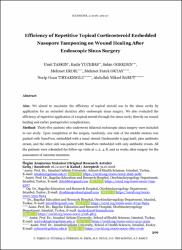Efficiency of Repetitive Topical Corticosteroid Embedded Nasopore Tamponing on Wound Healing After Endoscopic Sinus Surgery

Göster/
Tarih
2018-04-20Yazar
Taşkın, ÜmitYücebaş, Kadir
Öğreden, Şahin
Erdil, Mehmet
Oktay, Mehmet Faruk
Tiryakioğlu, Necip Ozan
Barut, Abdullah Yüksel
Üst veri
Tüm öğe kaydını gösterÖzet
Amaç: Endoskopik sinus cerrahisi (ESC) sonrası sinus boşluğunda uzun sureli topikal steroid uygulamasının etkilerini arttırmayı hedefledik. Ayrıca sinus boşluğuna tekrarlı topikal steroid uygulamasının doğrudan yara iyileşmesine ve erken postoperative komplikasyonların önlenmesine olan etkisini değerlendirdik. Yöntem: Çalışmaya bilateral endoskopik sinus cerrahisi uygulanan otuz beş hasta dahil edildi. Cerrahi müdahalenin tamamlanması sonrası orta meatusun bir tarafına nazal steroid içeren NasoPore (budesonide 0.5µg/2ml) ve antibiyotik krem diğer tarafına sadece antibiyotik krem yerleştirildi. Bütün hastalar 1.,2.,4.,8., ve 12. haftalarda müdahale sonuçlarının gözlemlenmesi amacıyla muayene edildi. Bulgular: Operasyon sonrası ilk üç ayda steroid uygulanan grupta ortalama sineşi, mukozal ödem ve doku granülasyonu skorları uygulanmayan gruba göre daha düşüktür. Fakat iki grup arasında istatistiksel olarak anlamlı bir fark gözlemlenememiştir. Ortalama ödem skoru steroid grubunda diğer gruba kıyasla önemli derecede daha düşüktür. Sonuç: ESC sonrası emilebilir nazal paket aracılığıyla steroid kullanımının oldukça güvenli olduğuna ve sineşi ve granülasyon gibi erken postoperatif ESC komplikasyonlarının önlenmesinde etkili olduğunu düşünmekteyiz. Aim: We aimed to maximize the efficiency of topical steroid use in the sinus cavity by application for an extended duration after endoscopic sinus surgery. We also evaluated the efficiency of repetitive application of a topical steroid through the sinus cavity directly on wound healing and earlier postoperative complications. Method: Thirty-five patients who underwent bilateral endoscopic sinus surgery were included in ou study. Upon completion of the surgery, randomly, one side of the middle meatus was packed with NasoPore, embedded with a nasal steroid (budesonide 0.5µg/2ml), plus antibiotic cream, and the other side was packed with NasoPore embedded with only antibiotic cream. All the patients were scheduled for follow-up visits at 1, 2, 4, 8, and 12 weeks after surgery for the assessment of outcome measures. Findings: The mean score of synechia, mucosal edema, and granulation tissue was lower in steroid embedded group than nonembedded one, during the first three months after surgery. However, there were no statistically significant differences between the two groups. The mean score of edema was significantly decreased in steroid embedded group when compared to other group. Conclusion: We believe that the use of a steroid embedded in an absorbable nasal packing after ESS is highly safe and effective in prevention of early postop ESS complications, including synechia and granulation.
















